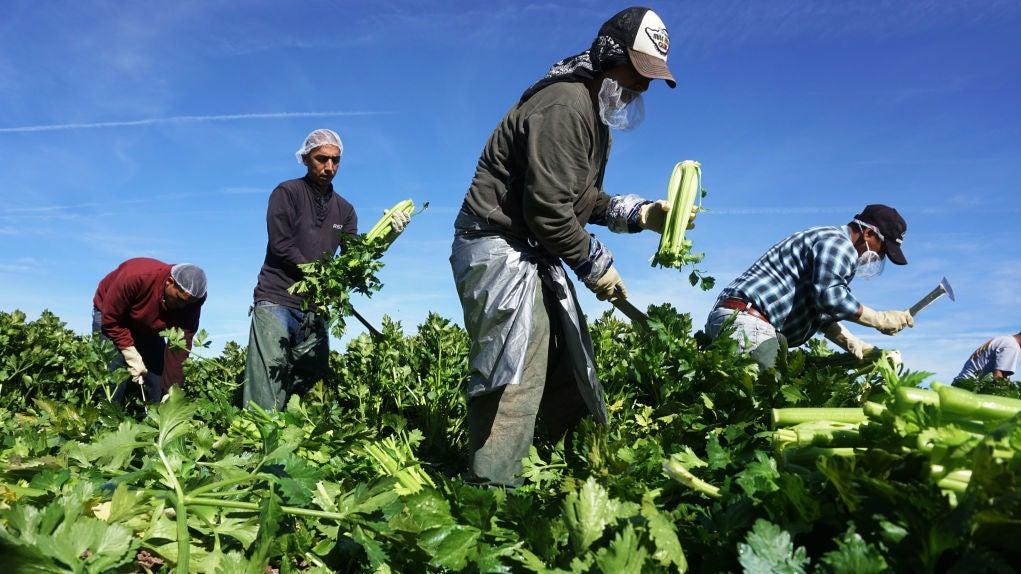How California's Heat Wave Impacts America's Food Supply
United Farm Workers are fighting for their rights amid California’s soaring temperatures.
If you haven't heard by now, let me tell you: California just endured a terrible heat wave. For over a week, temperatures were locked in triple digits during the day, inching down to a balmy 80 degrees at night. A heat wave exacerbates everything that's already going wrong: power infrastructures falter, unhoused people are put further in danger, and forests are more prone to fire. The reality of climate change becomes more... well, real. In America, California is a bellwether of our need to adapt.
On top of a drought now in its third year, the heat wave will add pressure onto California's massive agricultural industry. According to the California Department of Food and Agriculture (CDFA), "Over a third of the country's vegetables and three-quarters of the country's fruits and nuts are grown in California." Not included in that statistic is dairy, a $7.5 billion industry and America's largest. While a broccoli farm in the Imperial Valley or grapevines outside Fresno might sound distant, your groceries are directly tied to them.
The heat wave is a grim reminder that food is labor, and one group of people directly impacted is farm workers. Farming is an incredibly dangerous job: According to Civil Eats, farm workers are 20 times more likely to die from heat-related causes than other professions. In California, farm workers are largely Spanish-speaking, and about half are undocumented.
A brief history of California’s labor movement
After the California gold rush of the 1840s, the state shifted its economy to farming, with modern machinery and irrigation rendering the land incredibly productive.
However, farm workers were not included in the National Labor Relations Act of 1935, which provided those in other professions the ability to collectively bargain. The Fair Labor Standards Act of 1938, another benchmark labor act that expanded workers' rights, also specifically excluded farm workers. There were multiple reasons for this, racism and classism chief among them. Additionally, the farming industry had a powerful fingerprint in Washington, and according to the National Park Serivce, "They argued that farmworker unions could potentially threaten the nation's food supply and that higher wages would result in rising consumer prices for food and other basic commodities."
In 1942, the US government created the Mexican Farm Labor Program, aka the Bracero Program, an executive order meant to address a wartime labor shortage by bringing in Mexican workers on short-term work contracts. According to the Library of Congress, the Bracero program was used by farm owners as scabs: "Farmworkers worked in dire conditions... while receiving meager wages. Those who protested were replaced by Mexican braceros."
While Mexican farmworkers who migrated as braceros faced the same discrimination as workers already in America, the system was effective in keeping wages low. However, the Bracero Program was terminated at the end of 1964, and in its place, farm workers intended to organize.
The emergence of the United Farm Workers
The United Farm Workers (UFW) is most well known for its series of labor actions in the 1960s and '70s spearheaded by Cesar Chavez and Dolores Huerta, both Chicano organizers and activists. What gave them national notoriety was a 280-mile march from Delano, in the south Central Valley, to Sacramento, the state's capital, in 1966.
The march was organized by the United Farm Workers Organizing Committee (UFWOC), comprised of Chavez and Huerta's National Farm Workers Association and the Filipino Agricultural Workers Organizing Committee. One of the goals of the march was to get press and attention to the dangerous working conditions, meager pay, and prejudice that farmworkers faced. By the time the marchers reached the capital, a union contract had been successfully negotiated. In 1972, they dropped the "OC" to make "UFW," as they're known now.
During the '60s and '70s, UFW was able to secure hundreds of union contracts for farmworkers through grassroots organizing, boycotts, and strikes. The UFW even had its own short-form comedy troupe, "El Teatro Campesino."
In 2022, the heat wave has once again pulled the UFW and its "new clout" into focus. The UFW is throwing it back to its original calling card: The group marched from Delano to Sacramento this summer in order to put pressure on California governor Gavin Newsom to sign AB 2183, the Agricultural Labor Relations Voting Choice Act. During the scorching heat wave, UFW members rallied outside the Capitol.
What is AB 2183?
Farmworkers were granted the right to vote toward unionizing in 1975. Still, there is one big caveat, which is that workers have to vote at a specified polling place. The new assembly bill would give workers more flexibility in their voting options, allowing them to vote by mail, among other options. President Biden said he "strongly supports" AB 2183, yet at the time of this writing, it remains on Newsom's desk.
As the effects of climate change heighten, workers' rights will be crucial to keeping agriculture sustainable. California has many issues (water cutbacks are looming as the Colorado River dries up), but more robust protections for the people who put food on our tables is something we have the power to make happen, a necessary foundation for building a stronger tomorrow.
